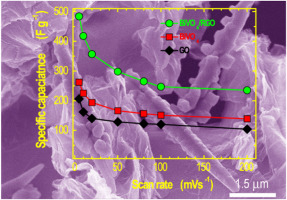Journal of Solid State Chemistry ( IF 3.2 ) Pub Date : 2018-10-13 , DOI: 10.1016/j.jssc.2018.10.011 Chinnasamy Sengottaiyan , Noordeen Abdul Kalam , Ramasamy Jayavel , Rekha Goswami Shrestha , Thiyagu Subramani , Sambasivam Sankar , Jonathan P. Hill , Lok Kumar Shrestha , Katsuhiko Ariga

|
Here we report electrochemical supercapacitance performance of a hybrid binary composite material composed of hierarchical bismuth vanadate (BiVO4) crystals embedded in reduced graphene oxide (RGO) sheets prepared by a one-pot hydrothermal method in the absence of structure-guiding agents. The resulting BiVO4/RGO composite material was characterized by powder X-ray diffraction, scanning and transmission electron microscopy, Raman scattering, Fourier transformed infrared and X-ray photoelectron spectroscopy. Cyclic voltammetry and chronopotentiometry charge/discharge measurements revealed that the BiVO4/RGO hybrid composite structure exhibits superior electrochemical performance with a specific capacitance of 484 F g−1 at a scan rate of 5 mV s−1 and 343 F g−1 at current density of 1 A g−1 as well as excellent cycling stability sustaining about 87% of the initial capacitance after 2000 charge/discharge cycles at 10 A g−1. These results indicate that this BiVO4/RGO hybrid material could be suitable as a supercapacitor electrode material for energy storage applications.
中文翻译:

用于高性能电化学超级电容器的BiVO 4 / RGO杂化纳米结构
在这里,我们报告了由二氧化钒钒(BiVO 4)晶体组成的混合二元复合材料的电化学超级电容性能,该晶体嵌入通过一锅水热法在不存在结构导向剂的情况下制备的还原氧化石墨烯(RGO)片中。通过粉末X射线衍射,扫描和透射电子显微镜,拉曼散射,傅立叶变换红外和X射线光电子能谱对所得的BiVO 4 / RGO复合材料进行表征。循环伏安法和计时电位法的充电/放电测量表明,BiVO 4 / RGO杂化复合结构具有优异的电化学性能,比电容为484 F g -1以5的扫描速率 毫伏 小号-1和343 ˚F 克-1以1个电流密度 甲 克-1以及优异的循环稳定性在10维持大约初始电容的87%2000的充电/放电循环后 甲 克- 1。这些结果表明,该BiVO 4 / RGO杂化材料可以适合用作储能应用的超级电容器电极材料。











































 京公网安备 11010802027423号
京公网安备 11010802027423号